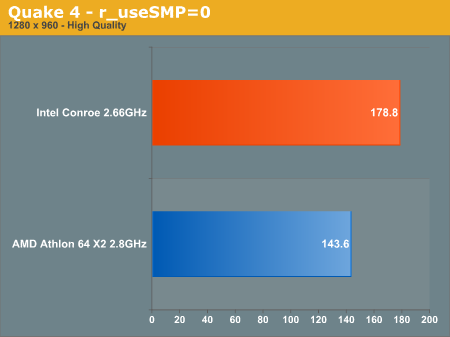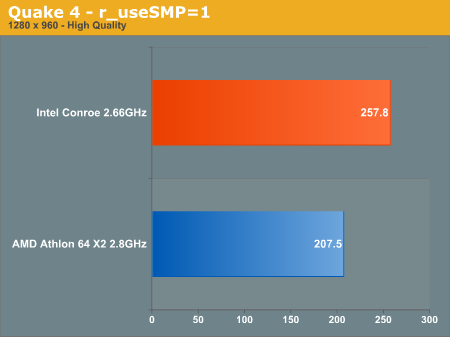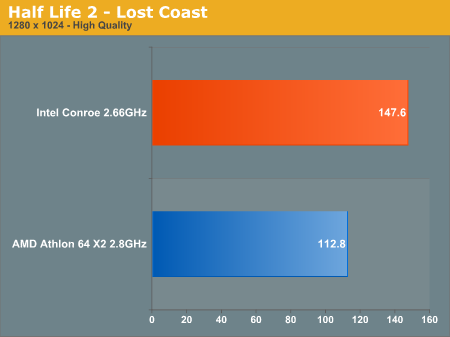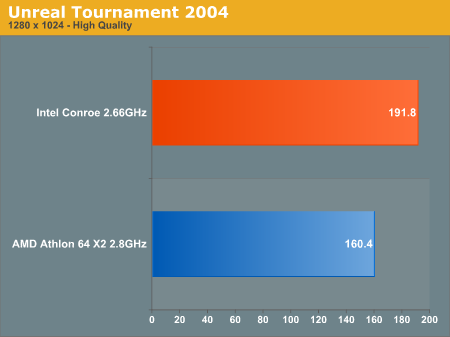Spring IDF 2006 Conroe Preview: Intel Regains the Performance Crown
by Anand Lal Shimpi on March 7, 2006 3:58 PM EST- Posted in
- Trade Shows
Gaming Performance
The one area where AMD has been the clear leader for years has been in gaming performance - Conroe changes everything.
Updated: In Don MacDonald's keynote he also provided us with another reference point for Conroe's performance, this time under Call of Duty 2. We have no idea what settings they ran at but the results we saw were Conroe at 111 fps and a Pentium Extreme Edition 3.73GHz scoring 90 fps. But the most interesting gaming tests are below:
First off we've got Quake 4 running the 1.0.5.0 patch at 1280 x 1024 with High Quality settings. The only demo available was Intel's own demo but nothing looked out of the ordinary with the recording. We tested with both r_useSMP enabled and disabled, first the SMP disabled numbers. Updated: The Quake 4 scores have been updated as mentioned in our follow-up article.

With SMP disabled, Conroe holds a 25% performance advantage over the 2.8GHz Athlon 64 X2. Enabling SMP provides a similar 24% performance advantage.

Next up is a Half Life 2 Lost Coast demo, once more an Intel supplied demo but there's only so much you can do to a demo recording to make it favor one CPU maker over another:

Conroe's performance advantage extends to 31% under Half Life 2, talk about a complete role reversal here.

We finish off this page with Unreal Tournament 2004 and a 20% performance advantage for Conroe.










220 Comments
View All Comments
IntelUser2000 - Wednesday, March 8, 2006 - link
WRONG. Look here: In the anand benchmarks, FEAR goes from 46FPS on a 7800GTX 512MB to 84FPS on the same card in SLI. This points to a game that is very video card limited.
Using Athlon 64 FX-57 CPU clocked same as the IDF FX-60 that is overclocked.
At 1280x1024, the resolution AT chose to test, 7800GTX 512MB only goes from 88 to 119, a gain of 33.7%, rather than the outrageous 82.6% gain, which is ONLY possible at the higher resolutions.
Even at 1600x1200, you are proven wrong. It gains from 46 to 69 a gain of 50%.
IntelUser2000 - Wednesday, March 8, 2006 - link
A link for AT's article: http://www.anandtech.com/video/showdoc.aspx?i=2607...">http://www.anandtech.com/video/showdoc.aspx?i=2607...
IntelUser2000 - Wednesday, March 8, 2006 - link
fikimiki - Wednesday, March 8, 2006 - link
If you look at IDF F.E.A.R. benchmark run by Anandtech and then lookhttp://www.anandtech.com/video/showdoc.aspx?i=2575...">here:
you will notice that AMD 2.8GHz and Conroe can achive amazing results (both):
I don't know what test Anand did during IDF but he wrote that THE SAME AS IN STANDARD HARDWARE TESTS.
Now if you look at performance achieved on nVidia 7800GTX+FX55 - you will see 74 fps.
I don't belive that demonstrated hardware can be 2,5x or faster than tested in Anand's labs.
Second, Intel didn't show any synthetic benchmarks - why?
Maybe because the results on 3dMark05 andn others show not what Intel expected when comparing one year old AMD design...
IntelUser2000 - Wednesday, March 8, 2006 - link
Yea yea yea whatever
http://www.anandtech.com/video/showdoc.aspx?i=2679...">http://www.anandtech.com/video/showdoc.aspx?i=2679...
Now if you see the link I gave above, you can see X1900XT's get 92 frames per second, while the IDF system is on CROSSFIRE!!!
Also we can see that the X1900XT review uses FX-57, which is same clock as the overclocked FX-60 on IDF system and can expect similar performance.
fikimiki - Wednesday, March 8, 2006 - link
So you see even with Crossfire it is difficult to achieve 100fps not to mention180 fps on Conroe. Let's wait for the real comparision on nForce, not previewed ATI chipset.
IntelUser2000 - Wednesday, March 8, 2006 - link
So you see even with Crossfire it is difficult to achieve 100fps not to mention180 fps on Conroe. Let's wait for the real comparision on nForce, not previewed ATI chipset.
Let me disapprove you. Go to here: http://www.tbreak.com/reviews/printpage.php?id=430">http://www.tbreak.com/reviews/printpage.php?id=430
Tbreak X2 4800+ 2.4GHz FEAR 1280x960: 124, and UNLIKE what you claim, it gets similar 96 fps on NON-CROSSFIRE X1900XT, and 29% better on Crossfire
IDF FX60 X 2.8GHz FEAR 1280x1024: 132, hey looking at clock speed differences, and the fact that IDF has SLIGHTLY better resolution, it looks about right
Tbreak X2 4800+ 2.4GHz Quake 4 1280x1024: 131.70, 123.60 without Crossfire
IDF FX60 X 2.8GHz Quake 4 1280x960, SMP off: 143.6
Though Tbreak's doesn't mention SMP being off, it correspond's to Anand's SMP off numbers, Again, looks about right.
Anyone doubting the POST screenshots, the REAL BIOS numbers are not shown, its at the bottom, where on the IDF pic, its cutoff, and as Jarred mentions, some boards do not recognize the CPU properly. But it seems that doesn't deter anything in performance does it??
JumpingJack - Thursday, March 9, 2006 - link
This is an interesting concept, has the rig been rigged...can FEAR actually run as shown....This site who also got an hour or so on the setup and re-tested at low resolution, eye candy off to ensure CPU limited performance:
http://www.bit-tech.net/news/2006/03/08/intel_conr...">http://www.bit-tech.net/news/2006/03/08/intel_conr...
Based on this data, it does appear that memory timings, C&Q default off or not, the result posted for the FX-60 at IDF and reference FX-60 are in the ballpark and seems to lend some credence to the AT results.
Interestingly synthetics are also at:
http://www.hexus.net/content/item.php?item=4843">http://www.hexus.net/content/item.php?item=4843
PrinceGaz - Wednesday, March 8, 2006 - link
You are missing the point.The benchmarks he linked to show that an FX-55 at stock-speeds (single-core, 2.6GHz) is quite capable of running the FEAR benchmark at well over 155fps -- at 640x480 the X1800XT averaged 155fps, and a 7800GTX averaged 153fps, and they were STILL GPU LIMITED as the framerate vs resolution was only slightly beginning to taper off indicating very little CPU limitation. It looks like the FX-55 would probably be able to average as much as 180fps with a faster graphics-card. Why then on the systems that Intel set up was an FX-60 clocked at 2.8GHz (higher than the FX-55) only able to average 135fps, whereas a Conroe at 2.6GHz averaged 186fps.
Now before you complain about different graphic cards (X1800XT instead of X1900XT Crossfire) and different resolutions (640x480 instead of 1280x1024), it doesn't matter which card or resolution you use so long as the test is CPU limited. Unfortunately it is still *GPU* limited on an X1800XT or 7800GTX even at 640x480, which suggests that even a pair of X1900XT cards will definitely be GPU limited at 1280x1024 despite having much higher pixel-shader power as they are having to deal with over four times as many pixels per frame.
So the problems with the test are:
1. Why is the FX-60 @ 2.8GHz giving a much lower FEAR benchmark score than would be expected if it truly was CPU limited?
2. A pair of X1900XT cards cannot give an average framerate of over 180fps in the FEAR benchmark at 1280x1024 regardless of the CPU, in fact they would struggle to achieve over 150fps. How come a Conroe magically lets them achieve 186fps?
3. Why on earth did the graphics-card driver need to be "modified to recognize the Conroe CPU"? What does it do differently when it detects a Conroe CPU? As far as I know, all the driver needs to know are what instructions the CPU supports (eg. SSE, SSE2 etc) and that does not rely on knowing the specific CPU model, only checking the CPU capability flags.
4. following on from no.3, what effect did the modifications Intel made to the driver have when it detected a non-Intel CPU? We all know from the Skype issue how Intel are quite happy to cripple features when running on non-Intel processors, or how Intel compilers have produced code that only used SSE etc on Intel processors. That gives the comment "but that driver was loaded on both AMD and Intel systems" a whole new meaning. It's speculation on my part but I wouldn't be surprised if the modified driver checks for CPU capabilities based on CPU model rather than capability flags, and that Intel only included their own processors in the list. I hope I'm wrong, but I wouldn't be surprised if I wasn't.
Now ideally Anand will bring back a CD from IDF with copies of the Intel game benchmark files, and also a copy of that Intel modified ATI driver on it so that he can run more extensive tests on systems he has set up, both with and without the modified driver.
Having said that, the media-encoding benchmarks on Conroe are very impressive but again we don't know if anything funny is going on with the setup. What do Intel have to gain by cheating you may ask? How about making people decide not to buy an Athlon 64 X2 over the next six months thus damaging AMDs slim profit-margin. If Conroe really is as good as the benchmarks suggest though, then AMD have some catching up to do-- probably by releasing the K8L core earlier than intended and using it into sectors other than only the server market.
Shintai - Wednesday, March 8, 2006 - link
You are paranoid.Both systems used x1900XT crossfire setup. The Conroe ran with DDR2-667 memory. When it ships it will run with DDR2-800.
For synthetic tests, here is a few:
http://www.hexus.net/content/item.php?item=4843&am...">http://www.hexus.net/content/item.php?item=4843&am...
And brace yourself for a 2.93Ghz Conroe in Q4, 65W aswell. Ohh..and let me give you all the prices so we dont have to argue about that too.
The SKUs are listed as up for sale in june/july for desktop and servers.
Mobile: (Merom) 667Mhz FSB, Dualcore, 65nm, 35W or below, i945/ICH7m/ICH8m.
T7600 2.33Ghz 4MB 640$
T7400 2.16Ghz 4MB 420$
T7200 2.00Ghz 4MB 295$
T5600 1.83Ghz 2MB (Singlecore) 240$
Desktop: (Conroe) 1066Mhz FSB, Dualcore, 65nm, 65W or below, i965/ICH8.
E6700 2.67Ghz 4MB 529$
E6600 2.40Ghz 4MB 315$
E6400 2.13Ghz 2MB 240$
E6300 1.86Ghz 2MB 210$
Desktop Extreme: (Conroe XE) 1333Mhz FSB, Dualcore, 65nm, 95W or below.
3.33Ghz 4MB, 999$
Server: (Woodcrest) 1333Mhz FSB, Dualcore, 65nm, 80W or below.
5160 3.00Ghz 4MB 850$
5150 2.67Ghz 4MB 700$
5140 2.33Ghz 4MB 470$
5130 2.00Ghz 4MB 330$
5120 1.86Ghz 4MB 270$
5110 1.60Ghz 4MB 230$